Importance of Lean Project Management
VerifiedAdded on 2023/03/21
|13
|3677
|30
AI Summary
This memo discusses the importance of implementing Lean project management principles for government works. It explores the benefits gained by stakeholders, critical success factors, and steps for achieving a Lean mindset. Training requirements and methods for adopting the Lean approach are also discussed.
Contribute Materials
Your contribution can guide someone’s learning journey. Share your
documents today.

Running head: MEMO
Lean project management
Name of the Student
Name of the University
Author’s Note
Lean project management
Name of the Student
Name of the University
Author’s Note
Secure Best Marks with AI Grader
Need help grading? Try our AI Grader for instant feedback on your assignments.
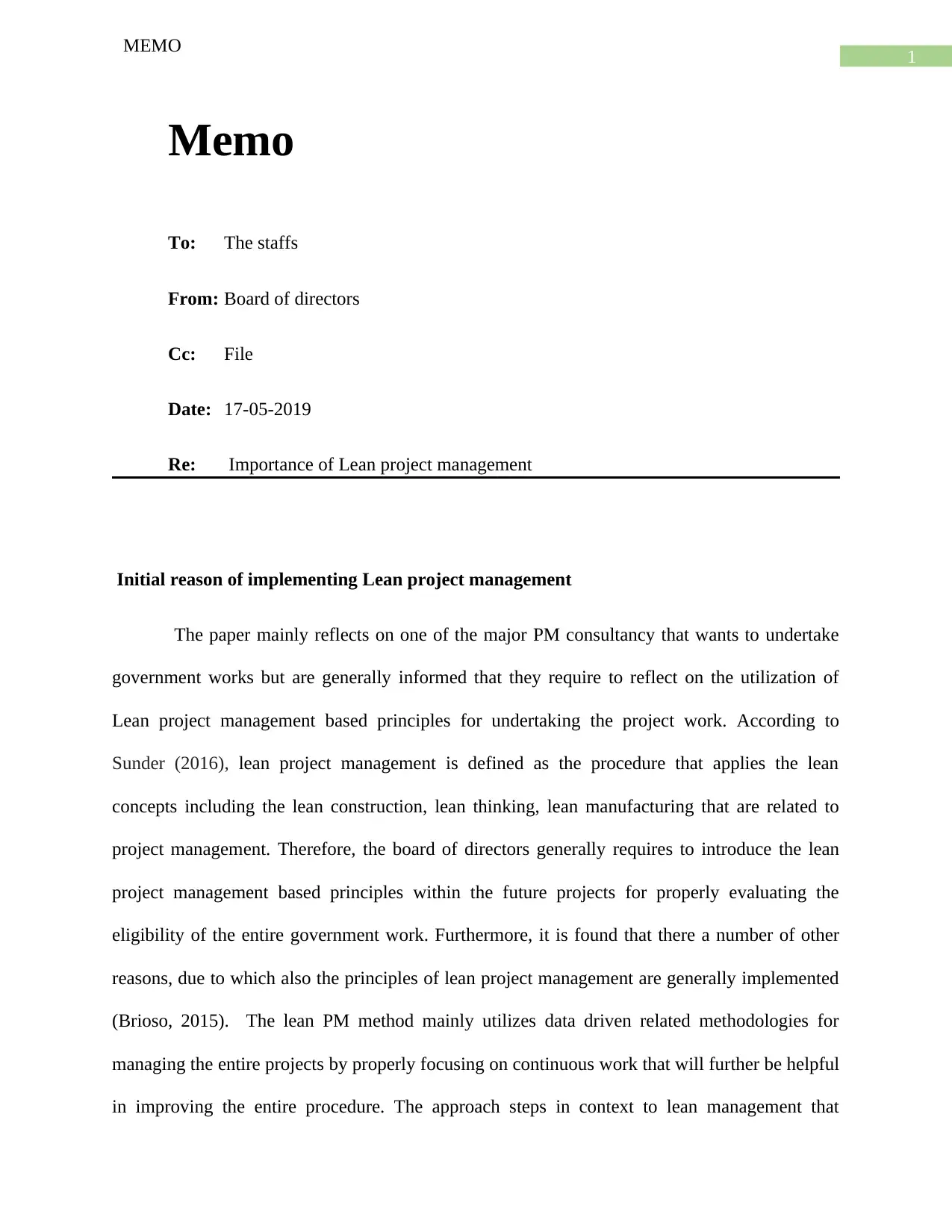
1
MEMO
Memo
To: The staffs
From: Board of directors
Cc: File
Date: 17-05-2019
Re: Importance of Lean project management
Initial reason of implementing Lean project management
The paper mainly reflects on one of the major PM consultancy that wants to undertake
government works but are generally informed that they require to reflect on the utilization of
Lean project management based principles for undertaking the project work. According to
Sunder (2016), lean project management is defined as the procedure that applies the lean
concepts including the lean construction, lean thinking, lean manufacturing that are related to
project management. Therefore, the board of directors generally requires to introduce the lean
project management based principles within the future projects for properly evaluating the
eligibility of the entire government work. Furthermore, it is found that there a number of other
reasons, due to which also the principles of lean project management are generally implemented
(Brioso, 2015). The lean PM method mainly utilizes data driven related methodologies for
managing the entire projects by properly focusing on continuous work that will further be helpful
in improving the entire procedure. The approach steps in context to lean management that
MEMO
Memo
To: The staffs
From: Board of directors
Cc: File
Date: 17-05-2019
Re: Importance of Lean project management
Initial reason of implementing Lean project management
The paper mainly reflects on one of the major PM consultancy that wants to undertake
government works but are generally informed that they require to reflect on the utilization of
Lean project management based principles for undertaking the project work. According to
Sunder (2016), lean project management is defined as the procedure that applies the lean
concepts including the lean construction, lean thinking, lean manufacturing that are related to
project management. Therefore, the board of directors generally requires to introduce the lean
project management based principles within the future projects for properly evaluating the
eligibility of the entire government work. Furthermore, it is found that there a number of other
reasons, due to which also the principles of lean project management are generally implemented
(Brioso, 2015). The lean PM method mainly utilizes data driven related methodologies for
managing the entire projects by properly focusing on continuous work that will further be helpful
in improving the entire procedure. The approach steps in context to lean management that

2
MEMO
generally emphasizes quality, empowered team, undertakes data analysis as well as assist in
improving the customer value. In addition to this, it is found the waste is generally eliminated
with the help of proper utilization of employee time, materials as well as various types of
financial resources.
Benefits gained by the stakeholders with the implementation of LPM
The benefits that are achieved by the stakeholders of the consultancy organization with
the implementation of lean project management are illustrated below:
Greater visibility: The most important as well as major component of the lean as well
as visual work management is that it helps in increasing the visibility of the project stakeholders
that further helps in improving the work progress by prioritizing the project tasks, term plans as
well as risks and status of the project (Sohi et al., 2016). Moreover, the team members as well as
other stakeholders can be able to get more information about the project.
Greater control: Knowledge is mainly considered as power and due to process access of
the knowledge, the team members can be able to properly manage the resources as well as risks
of the project quite effectively. The project team members are mainly empowered with the help
of the knowledge and can be able to make appropriate decisions that further results in much more
agile as well as appropriate development of the system for accomplishing the project goals.
Better products: With the help of the principles of lean project management, it is found
that more number of control options will be available that will further be useful for the project
stakeholders as they can be able to meet the goals as well as objectives of the project for the
delivery of the products to the different customers (Ansah, Sorooshian & Mustafa, 2016). When
MEMO
generally emphasizes quality, empowered team, undertakes data analysis as well as assist in
improving the customer value. In addition to this, it is found the waste is generally eliminated
with the help of proper utilization of employee time, materials as well as various types of
financial resources.
Benefits gained by the stakeholders with the implementation of LPM
The benefits that are achieved by the stakeholders of the consultancy organization with
the implementation of lean project management are illustrated below:
Greater visibility: The most important as well as major component of the lean as well
as visual work management is that it helps in increasing the visibility of the project stakeholders
that further helps in improving the work progress by prioritizing the project tasks, term plans as
well as risks and status of the project (Sohi et al., 2016). Moreover, the team members as well as
other stakeholders can be able to get more information about the project.
Greater control: Knowledge is mainly considered as power and due to process access of
the knowledge, the team members can be able to properly manage the resources as well as risks
of the project quite effectively. The project team members are mainly empowered with the help
of the knowledge and can be able to make appropriate decisions that further results in much more
agile as well as appropriate development of the system for accomplishing the project goals.
Better products: With the help of the principles of lean project management, it is found
that more number of control options will be available that will further be useful for the project
stakeholders as they can be able to meet the goals as well as objectives of the project for the
delivery of the products to the different customers (Ansah, Sorooshian & Mustafa, 2016). When
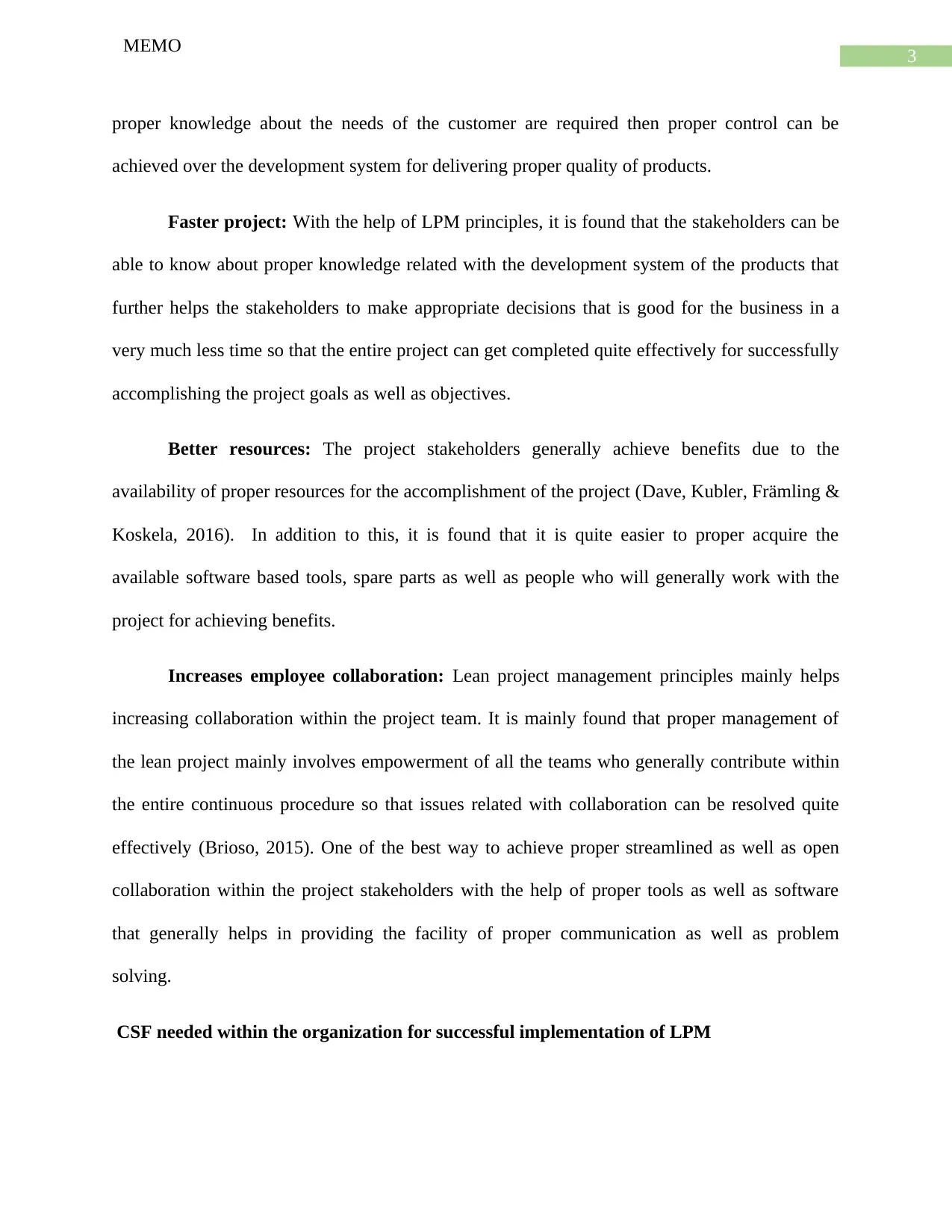
3
MEMO
proper knowledge about the needs of the customer are required then proper control can be
achieved over the development system for delivering proper quality of products.
Faster project: With the help of LPM principles, it is found that the stakeholders can be
able to know about proper knowledge related with the development system of the products that
further helps the stakeholders to make appropriate decisions that is good for the business in a
very much less time so that the entire project can get completed quite effectively for successfully
accomplishing the project goals as well as objectives.
Better resources: The project stakeholders generally achieve benefits due to the
availability of proper resources for the accomplishment of the project (Dave, Kubler, Främling &
Koskela, 2016). In addition to this, it is found that it is quite easier to proper acquire the
available software based tools, spare parts as well as people who will generally work with the
project for achieving benefits.
Increases employee collaboration: Lean project management principles mainly helps
increasing collaboration within the project team. It is mainly found that proper management of
the lean project mainly involves empowerment of all the teams who generally contribute within
the entire continuous procedure so that issues related with collaboration can be resolved quite
effectively (Brioso, 2015). One of the best way to achieve proper streamlined as well as open
collaboration within the project stakeholders with the help of proper tools as well as software
that generally helps in providing the facility of proper communication as well as problem
solving.
CSF needed within the organization for successful implementation of LPM
MEMO
proper knowledge about the needs of the customer are required then proper control can be
achieved over the development system for delivering proper quality of products.
Faster project: With the help of LPM principles, it is found that the stakeholders can be
able to know about proper knowledge related with the development system of the products that
further helps the stakeholders to make appropriate decisions that is good for the business in a
very much less time so that the entire project can get completed quite effectively for successfully
accomplishing the project goals as well as objectives.
Better resources: The project stakeholders generally achieve benefits due to the
availability of proper resources for the accomplishment of the project (Dave, Kubler, Främling &
Koskela, 2016). In addition to this, it is found that it is quite easier to proper acquire the
available software based tools, spare parts as well as people who will generally work with the
project for achieving benefits.
Increases employee collaboration: Lean project management principles mainly helps
increasing collaboration within the project team. It is mainly found that proper management of
the lean project mainly involves empowerment of all the teams who generally contribute within
the entire continuous procedure so that issues related with collaboration can be resolved quite
effectively (Brioso, 2015). One of the best way to achieve proper streamlined as well as open
collaboration within the project stakeholders with the help of proper tools as well as software
that generally helps in providing the facility of proper communication as well as problem
solving.
CSF needed within the organization for successful implementation of LPM
Secure Best Marks with AI Grader
Need help grading? Try our AI Grader for instant feedback on your assignments.
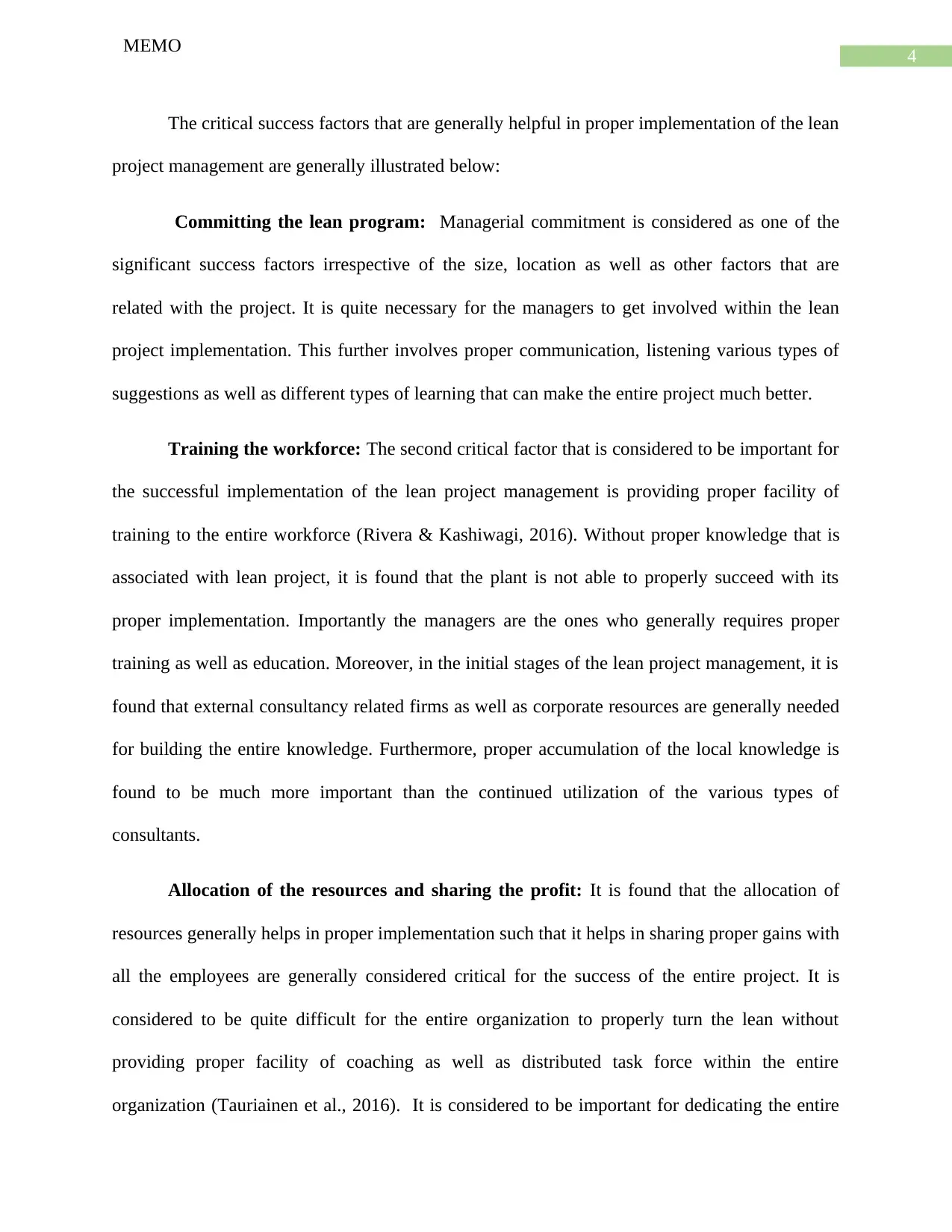
4
MEMO
The critical success factors that are generally helpful in proper implementation of the lean
project management are generally illustrated below:
Committing the lean program: Managerial commitment is considered as one of the
significant success factors irrespective of the size, location as well as other factors that are
related with the project. It is quite necessary for the managers to get involved within the lean
project implementation. This further involves proper communication, listening various types of
suggestions as well as different types of learning that can make the entire project much better.
Training the workforce: The second critical factor that is considered to be important for
the successful implementation of the lean project management is providing proper facility of
training to the entire workforce (Rivera & Kashiwagi, 2016). Without proper knowledge that is
associated with lean project, it is found that the plant is not able to properly succeed with its
proper implementation. Importantly the managers are the ones who generally requires proper
training as well as education. Moreover, in the initial stages of the lean project management, it is
found that external consultancy related firms as well as corporate resources are generally needed
for building the entire knowledge. Furthermore, proper accumulation of the local knowledge is
found to be much more important than the continued utilization of the various types of
consultants.
Allocation of the resources and sharing the profit: It is found that the allocation of
resources generally helps in proper implementation such that it helps in sharing proper gains with
all the employees are generally considered critical for the success of the entire project. It is
considered to be quite difficult for the entire organization to properly turn the lean without
providing proper facility of coaching as well as distributed task force within the entire
organization (Tauriainen et al., 2016). It is considered to be important for dedicating the entire
MEMO
The critical success factors that are generally helpful in proper implementation of the lean
project management are generally illustrated below:
Committing the lean program: Managerial commitment is considered as one of the
significant success factors irrespective of the size, location as well as other factors that are
related with the project. It is quite necessary for the managers to get involved within the lean
project implementation. This further involves proper communication, listening various types of
suggestions as well as different types of learning that can make the entire project much better.
Training the workforce: The second critical factor that is considered to be important for
the successful implementation of the lean project management is providing proper facility of
training to the entire workforce (Rivera & Kashiwagi, 2016). Without proper knowledge that is
associated with lean project, it is found that the plant is not able to properly succeed with its
proper implementation. Importantly the managers are the ones who generally requires proper
training as well as education. Moreover, in the initial stages of the lean project management, it is
found that external consultancy related firms as well as corporate resources are generally needed
for building the entire knowledge. Furthermore, proper accumulation of the local knowledge is
found to be much more important than the continued utilization of the various types of
consultants.
Allocation of the resources and sharing the profit: It is found that the allocation of
resources generally helps in proper implementation such that it helps in sharing proper gains with
all the employees are generally considered critical for the success of the entire project. It is
considered to be quite difficult for the entire organization to properly turn the lean without
providing proper facility of coaching as well as distributed task force within the entire
organization (Tauriainen et al., 2016). It is considered to be important for dedicating the entire
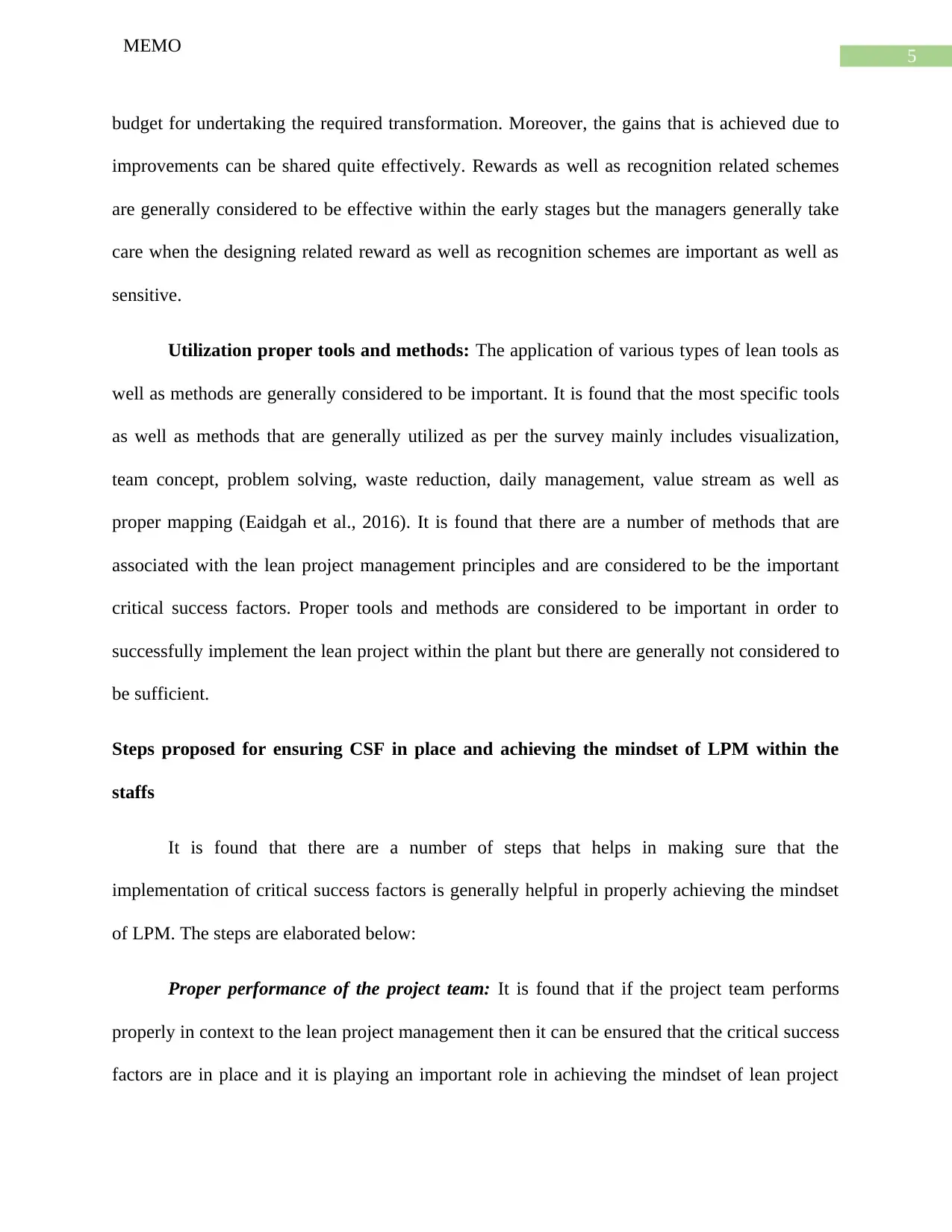
5
MEMO
budget for undertaking the required transformation. Moreover, the gains that is achieved due to
improvements can be shared quite effectively. Rewards as well as recognition related schemes
are generally considered to be effective within the early stages but the managers generally take
care when the designing related reward as well as recognition schemes are important as well as
sensitive.
Utilization proper tools and methods: The application of various types of lean tools as
well as methods are generally considered to be important. It is found that the most specific tools
as well as methods that are generally utilized as per the survey mainly includes visualization,
team concept, problem solving, waste reduction, daily management, value stream as well as
proper mapping (Eaidgah et al., 2016). It is found that there are a number of methods that are
associated with the lean project management principles and are considered to be the important
critical success factors. Proper tools and methods are considered to be important in order to
successfully implement the lean project within the plant but there are generally not considered to
be sufficient.
Steps proposed for ensuring CSF in place and achieving the mindset of LPM within the
staffs
It is found that there are a number of steps that helps in making sure that the
implementation of critical success factors is generally helpful in properly achieving the mindset
of LPM. The steps are elaborated below:
Proper performance of the project team: It is found that if the project team performs
properly in context to the lean project management then it can be ensured that the critical success
factors are in place and it is playing an important role in achieving the mindset of lean project
MEMO
budget for undertaking the required transformation. Moreover, the gains that is achieved due to
improvements can be shared quite effectively. Rewards as well as recognition related schemes
are generally considered to be effective within the early stages but the managers generally take
care when the designing related reward as well as recognition schemes are important as well as
sensitive.
Utilization proper tools and methods: The application of various types of lean tools as
well as methods are generally considered to be important. It is found that the most specific tools
as well as methods that are generally utilized as per the survey mainly includes visualization,
team concept, problem solving, waste reduction, daily management, value stream as well as
proper mapping (Eaidgah et al., 2016). It is found that there are a number of methods that are
associated with the lean project management principles and are considered to be the important
critical success factors. Proper tools and methods are considered to be important in order to
successfully implement the lean project within the plant but there are generally not considered to
be sufficient.
Steps proposed for ensuring CSF in place and achieving the mindset of LPM within the
staffs
It is found that there are a number of steps that helps in making sure that the
implementation of critical success factors is generally helpful in properly achieving the mindset
of LPM. The steps are elaborated below:
Proper performance of the project team: It is found that if the project team performs
properly in context to the lean project management then it can be ensured that the critical success
factors are in place and it is playing an important role in achieving the mindset of lean project
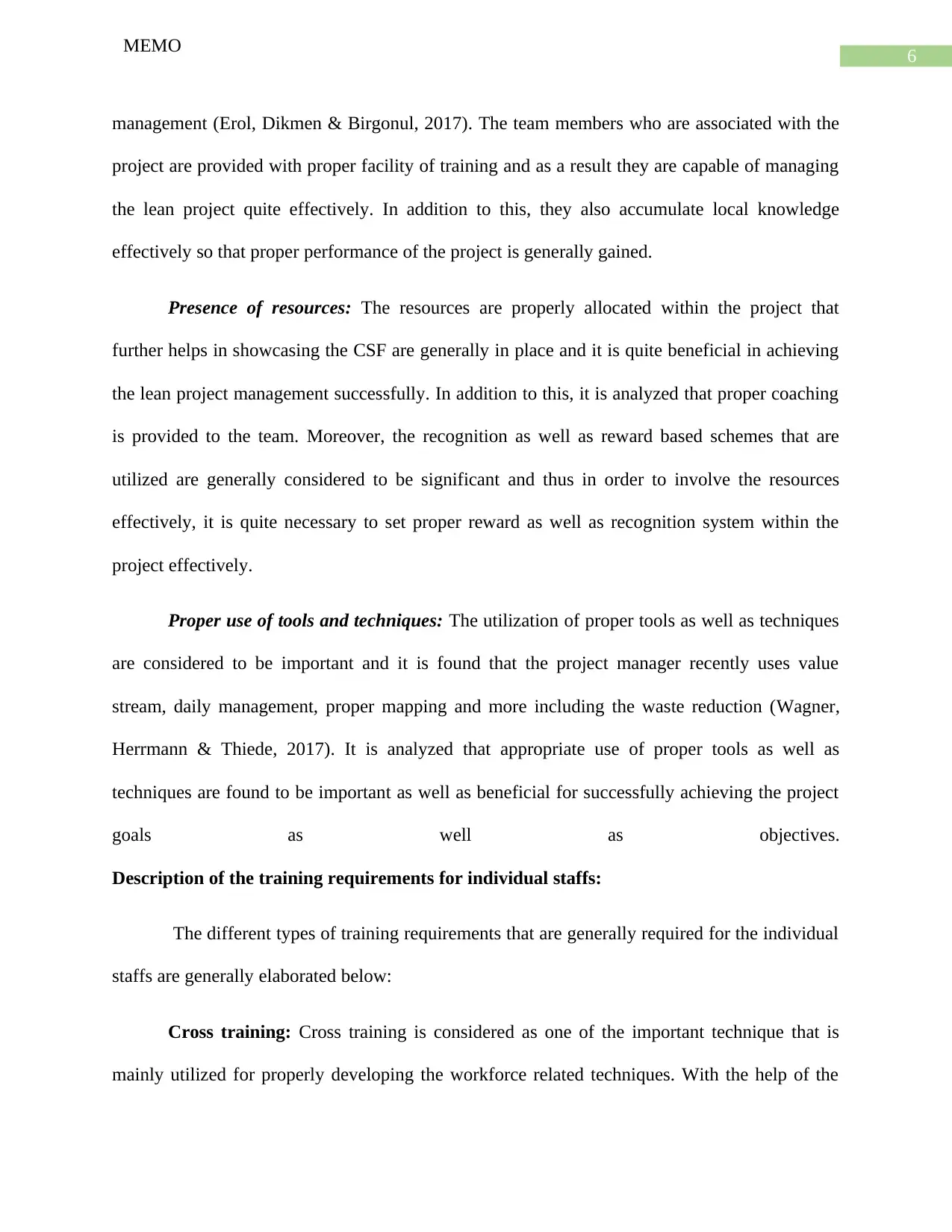
6
MEMO
management (Erol, Dikmen & Birgonul, 2017). The team members who are associated with the
project are provided with proper facility of training and as a result they are capable of managing
the lean project quite effectively. In addition to this, they also accumulate local knowledge
effectively so that proper performance of the project is generally gained.
Presence of resources: The resources are properly allocated within the project that
further helps in showcasing the CSF are generally in place and it is quite beneficial in achieving
the lean project management successfully. In addition to this, it is analyzed that proper coaching
is provided to the team. Moreover, the recognition as well as reward based schemes that are
utilized are generally considered to be significant and thus in order to involve the resources
effectively, it is quite necessary to set proper reward as well as recognition system within the
project effectively.
Proper use of tools and techniques: The utilization of proper tools as well as techniques
are considered to be important and it is found that the project manager recently uses value
stream, daily management, proper mapping and more including the waste reduction (Wagner,
Herrmann & Thiede, 2017). It is analyzed that appropriate use of proper tools as well as
techniques are found to be important as well as beneficial for successfully achieving the project
goals as well as objectives.
Description of the training requirements for individual staffs:
The different types of training requirements that are generally required for the individual
staffs are generally elaborated below:
Cross training: Cross training is considered as one of the important technique that is
mainly utilized for properly developing the workforce related techniques. With the help of the
MEMO
management (Erol, Dikmen & Birgonul, 2017). The team members who are associated with the
project are provided with proper facility of training and as a result they are capable of managing
the lean project quite effectively. In addition to this, they also accumulate local knowledge
effectively so that proper performance of the project is generally gained.
Presence of resources: The resources are properly allocated within the project that
further helps in showcasing the CSF are generally in place and it is quite beneficial in achieving
the lean project management successfully. In addition to this, it is analyzed that proper coaching
is provided to the team. Moreover, the recognition as well as reward based schemes that are
utilized are generally considered to be significant and thus in order to involve the resources
effectively, it is quite necessary to set proper reward as well as recognition system within the
project effectively.
Proper use of tools and techniques: The utilization of proper tools as well as techniques
are considered to be important and it is found that the project manager recently uses value
stream, daily management, proper mapping and more including the waste reduction (Wagner,
Herrmann & Thiede, 2017). It is analyzed that appropriate use of proper tools as well as
techniques are found to be important as well as beneficial for successfully achieving the project
goals as well as objectives.
Description of the training requirements for individual staffs:
The different types of training requirements that are generally required for the individual
staffs are generally elaborated below:
Cross training: Cross training is considered as one of the important technique that is
mainly utilized for properly developing the workforce related techniques. With the help of the
Paraphrase This Document
Need a fresh take? Get an instant paraphrase of this document with our AI Paraphraser
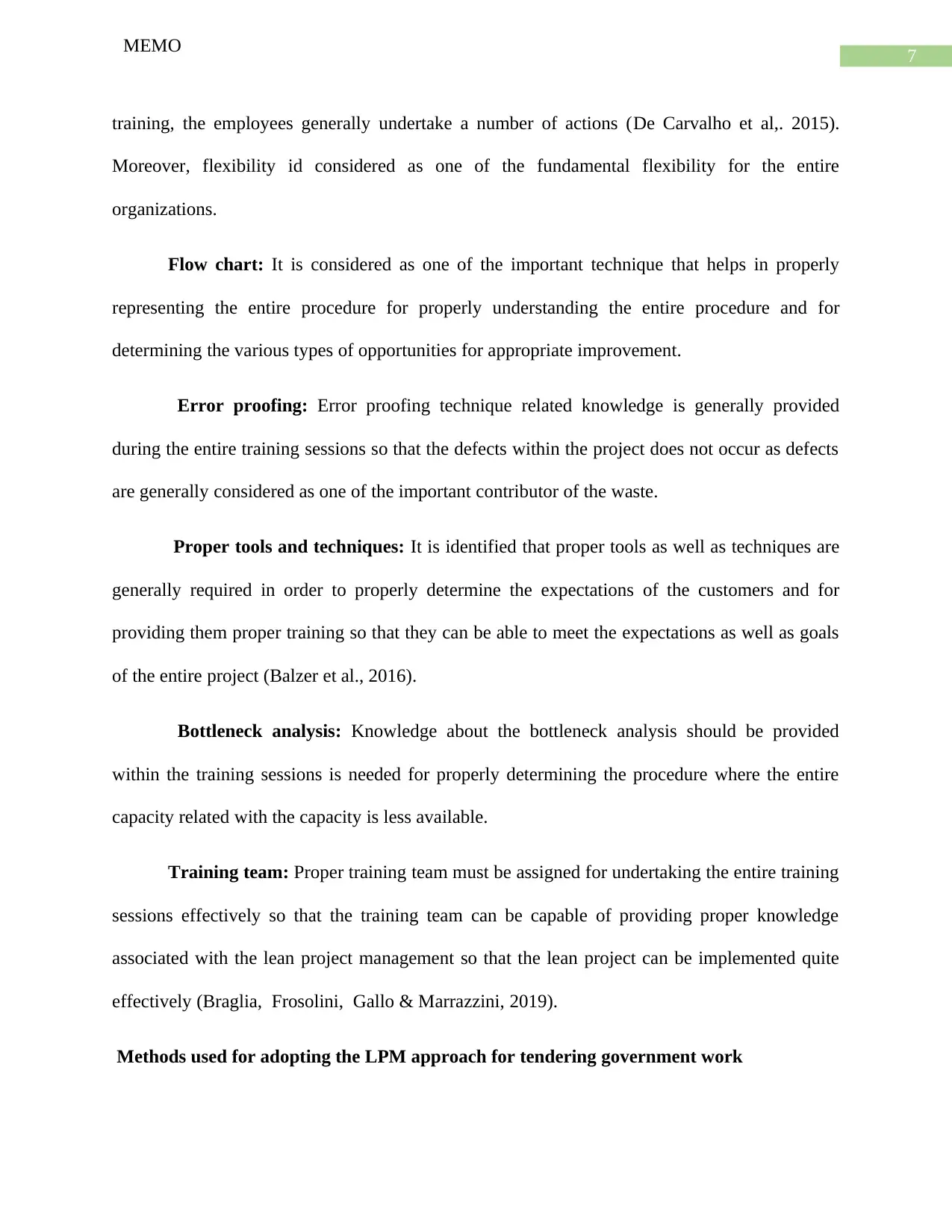
7
MEMO
training, the employees generally undertake a number of actions (De Carvalho et al,. 2015).
Moreover, flexibility id considered as one of the fundamental flexibility for the entire
organizations.
Flow chart: It is considered as one of the important technique that helps in properly
representing the entire procedure for properly understanding the entire procedure and for
determining the various types of opportunities for appropriate improvement.
Error proofing: Error proofing technique related knowledge is generally provided
during the entire training sessions so that the defects within the project does not occur as defects
are generally considered as one of the important contributor of the waste.
Proper tools and techniques: It is identified that proper tools as well as techniques are
generally required in order to properly determine the expectations of the customers and for
providing them proper training so that they can be able to meet the expectations as well as goals
of the entire project (Balzer et al., 2016).
Bottleneck analysis: Knowledge about the bottleneck analysis should be provided
within the training sessions is needed for properly determining the procedure where the entire
capacity related with the capacity is less available.
Training team: Proper training team must be assigned for undertaking the entire training
sessions effectively so that the training team can be capable of providing proper knowledge
associated with the lean project management so that the lean project can be implemented quite
effectively (Braglia, Frosolini, Gallo & Marrazzini, 2019).
Methods used for adopting the LPM approach for tendering government work
MEMO
training, the employees generally undertake a number of actions (De Carvalho et al,. 2015).
Moreover, flexibility id considered as one of the fundamental flexibility for the entire
organizations.
Flow chart: It is considered as one of the important technique that helps in properly
representing the entire procedure for properly understanding the entire procedure and for
determining the various types of opportunities for appropriate improvement.
Error proofing: Error proofing technique related knowledge is generally provided
during the entire training sessions so that the defects within the project does not occur as defects
are generally considered as one of the important contributor of the waste.
Proper tools and techniques: It is identified that proper tools as well as techniques are
generally required in order to properly determine the expectations of the customers and for
providing them proper training so that they can be able to meet the expectations as well as goals
of the entire project (Balzer et al., 2016).
Bottleneck analysis: Knowledge about the bottleneck analysis should be provided
within the training sessions is needed for properly determining the procedure where the entire
capacity related with the capacity is less available.
Training team: Proper training team must be assigned for undertaking the entire training
sessions effectively so that the training team can be capable of providing proper knowledge
associated with the lean project management so that the lean project can be implemented quite
effectively (Braglia, Frosolini, Gallo & Marrazzini, 2019).
Methods used for adopting the LPM approach for tendering government work
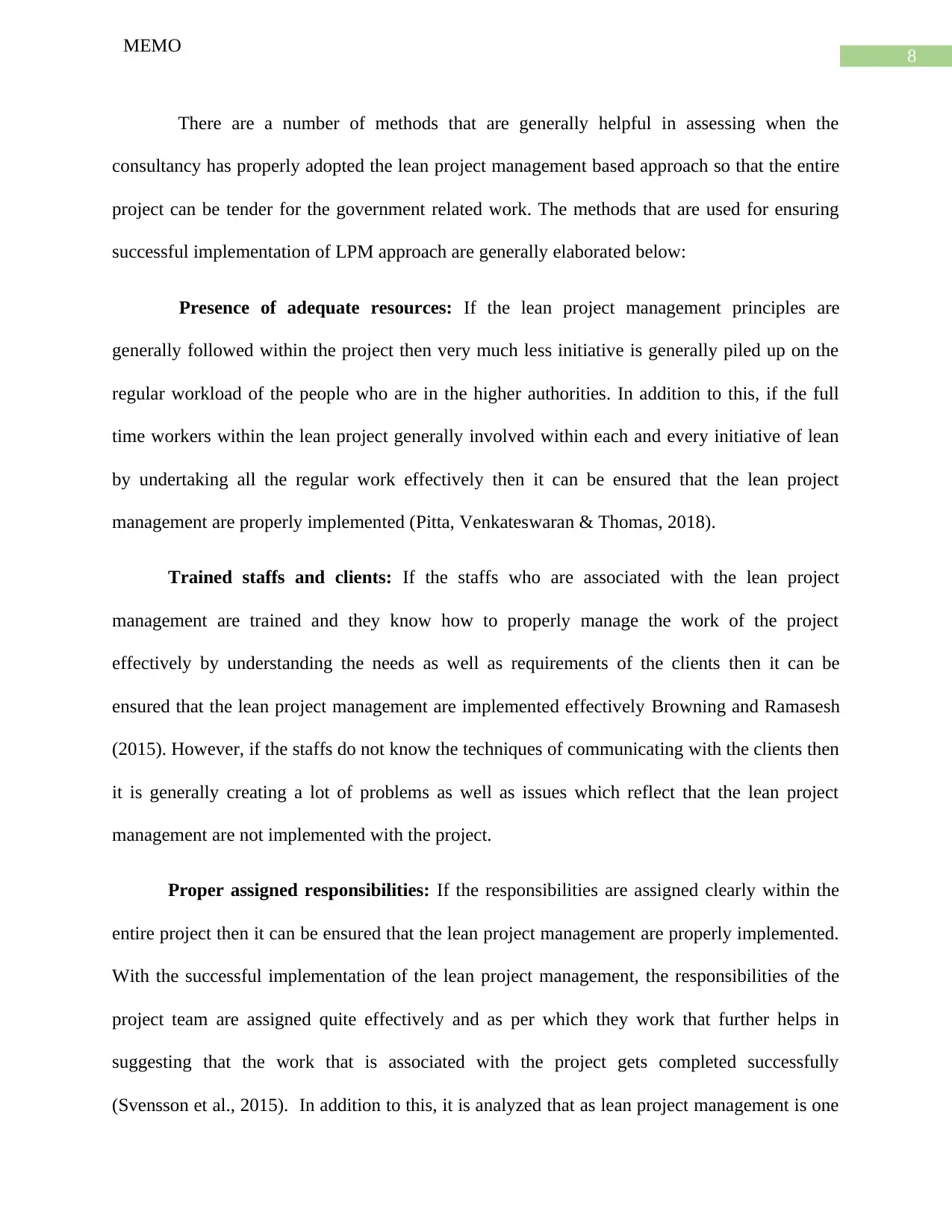
8
MEMO
There are a number of methods that are generally helpful in assessing when the
consultancy has properly adopted the lean project management based approach so that the entire
project can be tender for the government related work. The methods that are used for ensuring
successful implementation of LPM approach are generally elaborated below:
Presence of adequate resources: If the lean project management principles are
generally followed within the project then very much less initiative is generally piled up on the
regular workload of the people who are in the higher authorities. In addition to this, if the full
time workers within the lean project generally involved within each and every initiative of lean
by undertaking all the regular work effectively then it can be ensured that the lean project
management are properly implemented (Pitta, Venkateswaran & Thomas, 2018).
Trained staffs and clients: If the staffs who are associated with the lean project
management are trained and they know how to properly manage the work of the project
effectively by understanding the needs as well as requirements of the clients then it can be
ensured that the lean project management are implemented effectively Browning and Ramasesh
(2015). However, if the staffs do not know the techniques of communicating with the clients then
it is generally creating a lot of problems as well as issues which reflect that the lean project
management are not implemented with the project.
Proper assigned responsibilities: If the responsibilities are assigned clearly within the
entire project then it can be ensured that the lean project management are properly implemented.
With the successful implementation of the lean project management, the responsibilities of the
project team are assigned quite effectively and as per which they work that further helps in
suggesting that the work that is associated with the project gets completed successfully
(Svensson et al., 2015). In addition to this, it is analyzed that as lean project management is one
MEMO
There are a number of methods that are generally helpful in assessing when the
consultancy has properly adopted the lean project management based approach so that the entire
project can be tender for the government related work. The methods that are used for ensuring
successful implementation of LPM approach are generally elaborated below:
Presence of adequate resources: If the lean project management principles are
generally followed within the project then very much less initiative is generally piled up on the
regular workload of the people who are in the higher authorities. In addition to this, if the full
time workers within the lean project generally involved within each and every initiative of lean
by undertaking all the regular work effectively then it can be ensured that the lean project
management are properly implemented (Pitta, Venkateswaran & Thomas, 2018).
Trained staffs and clients: If the staffs who are associated with the lean project
management are trained and they know how to properly manage the work of the project
effectively by understanding the needs as well as requirements of the clients then it can be
ensured that the lean project management are implemented effectively Browning and Ramasesh
(2015). However, if the staffs do not know the techniques of communicating with the clients then
it is generally creating a lot of problems as well as issues which reflect that the lean project
management are not implemented with the project.
Proper assigned responsibilities: If the responsibilities are assigned clearly within the
entire project then it can be ensured that the lean project management are properly implemented.
With the successful implementation of the lean project management, the responsibilities of the
project team are assigned quite effectively and as per which they work that further helps in
suggesting that the work that is associated with the project gets completed successfully
(Svensson et al., 2015). In addition to this, it is analyzed that as lean project management is one
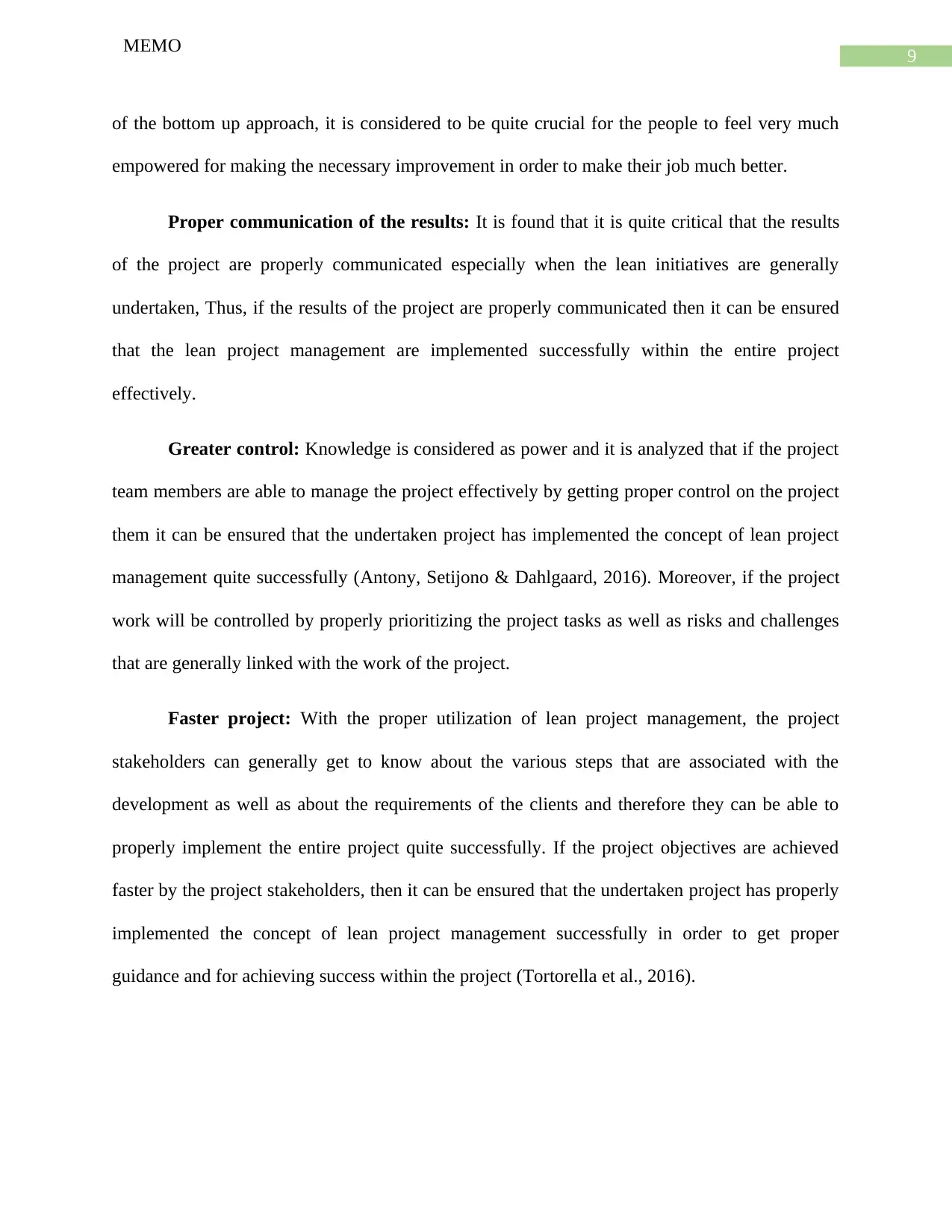
9
MEMO
of the bottom up approach, it is considered to be quite crucial for the people to feel very much
empowered for making the necessary improvement in order to make their job much better.
Proper communication of the results: It is found that it is quite critical that the results
of the project are properly communicated especially when the lean initiatives are generally
undertaken, Thus, if the results of the project are properly communicated then it can be ensured
that the lean project management are implemented successfully within the entire project
effectively.
Greater control: Knowledge is considered as power and it is analyzed that if the project
team members are able to manage the project effectively by getting proper control on the project
them it can be ensured that the undertaken project has implemented the concept of lean project
management quite successfully (Antony, Setijono & Dahlgaard, 2016). Moreover, if the project
work will be controlled by properly prioritizing the project tasks as well as risks and challenges
that are generally linked with the work of the project.
Faster project: With the proper utilization of lean project management, the project
stakeholders can generally get to know about the various steps that are associated with the
development as well as about the requirements of the clients and therefore they can be able to
properly implement the entire project quite successfully. If the project objectives are achieved
faster by the project stakeholders, then it can be ensured that the undertaken project has properly
implemented the concept of lean project management successfully in order to get proper
guidance and for achieving success within the project (Tortorella et al., 2016).
MEMO
of the bottom up approach, it is considered to be quite crucial for the people to feel very much
empowered for making the necessary improvement in order to make their job much better.
Proper communication of the results: It is found that it is quite critical that the results
of the project are properly communicated especially when the lean initiatives are generally
undertaken, Thus, if the results of the project are properly communicated then it can be ensured
that the lean project management are implemented successfully within the entire project
effectively.
Greater control: Knowledge is considered as power and it is analyzed that if the project
team members are able to manage the project effectively by getting proper control on the project
them it can be ensured that the undertaken project has implemented the concept of lean project
management quite successfully (Antony, Setijono & Dahlgaard, 2016). Moreover, if the project
work will be controlled by properly prioritizing the project tasks as well as risks and challenges
that are generally linked with the work of the project.
Faster project: With the proper utilization of lean project management, the project
stakeholders can generally get to know about the various steps that are associated with the
development as well as about the requirements of the clients and therefore they can be able to
properly implement the entire project quite successfully. If the project objectives are achieved
faster by the project stakeholders, then it can be ensured that the undertaken project has properly
implemented the concept of lean project management successfully in order to get proper
guidance and for achieving success within the project (Tortorella et al., 2016).
Secure Best Marks with AI Grader
Need help grading? Try our AI Grader for instant feedback on your assignments.

10
MEMO
References
Ansah, R. H., Sorooshian, S., & Mustafa, S. B. (2016). Lean construction: an effective approach
for project management. ARPN Journal of Engineering and Applied Sciences, 11(3),
1607-1612.
Antony, J., Setijono, D., & Dahlgaard, J. J. (2016). Lean Six Sigma and innovation–an
exploratory study among UK organisations. Total Quality Management & Business
Excellence, 27(1-2), 124-140.
Antony, J., Rodgers, B., Coull, I., & Sunder M, V. (2018). Lean Six Sigma in policing services:
A case study from an organisational learning perspective. International Journal of
Productivity and Performance Management, 67(5), 935-940.
Balzer, W. K., Francis, D. E., Krehbiel, T. C., & Shea, N. (2016). A review and perspective on
Lean in higher education. Quality assurance in education, 24(4), 442-462.
Braglia, M., Frosolini, M., Gallo, M., & Marrazzini, L. (2019). Lean manufacturing tool in
engineer-to-order environment: Project cost deployment. International Journal of
Production Research, 57(6), 1825-1839.
Brioso, X. (2015). Integrating ISO 21500 guidance on project management, lean construction
and PMBOK. Procedia Engineering, 123, 76-84.
Brioso, X. (2015). Teaching lean construction: Pontifical Catholic University of Peru training
course in lean project & construction management. Procedia Engineering, 123, 85-93.
Browning, T. R., & Ramasesh, R. V. (2015). Reducing unwelcome surprises in project
management. MIT Sloan Management Review, 56(3), 53.
MEMO
References
Ansah, R. H., Sorooshian, S., & Mustafa, S. B. (2016). Lean construction: an effective approach
for project management. ARPN Journal of Engineering and Applied Sciences, 11(3),
1607-1612.
Antony, J., Setijono, D., & Dahlgaard, J. J. (2016). Lean Six Sigma and innovation–an
exploratory study among UK organisations. Total Quality Management & Business
Excellence, 27(1-2), 124-140.
Antony, J., Rodgers, B., Coull, I., & Sunder M, V. (2018). Lean Six Sigma in policing services:
A case study from an organisational learning perspective. International Journal of
Productivity and Performance Management, 67(5), 935-940.
Balzer, W. K., Francis, D. E., Krehbiel, T. C., & Shea, N. (2016). A review and perspective on
Lean in higher education. Quality assurance in education, 24(4), 442-462.
Braglia, M., Frosolini, M., Gallo, M., & Marrazzini, L. (2019). Lean manufacturing tool in
engineer-to-order environment: Project cost deployment. International Journal of
Production Research, 57(6), 1825-1839.
Brioso, X. (2015). Integrating ISO 21500 guidance on project management, lean construction
and PMBOK. Procedia Engineering, 123, 76-84.
Brioso, X. (2015). Teaching lean construction: Pontifical Catholic University of Peru training
course in lean project & construction management. Procedia Engineering, 123, 85-93.
Browning, T. R., & Ramasesh, R. V. (2015). Reducing unwelcome surprises in project
management. MIT Sloan Management Review, 56(3), 53.
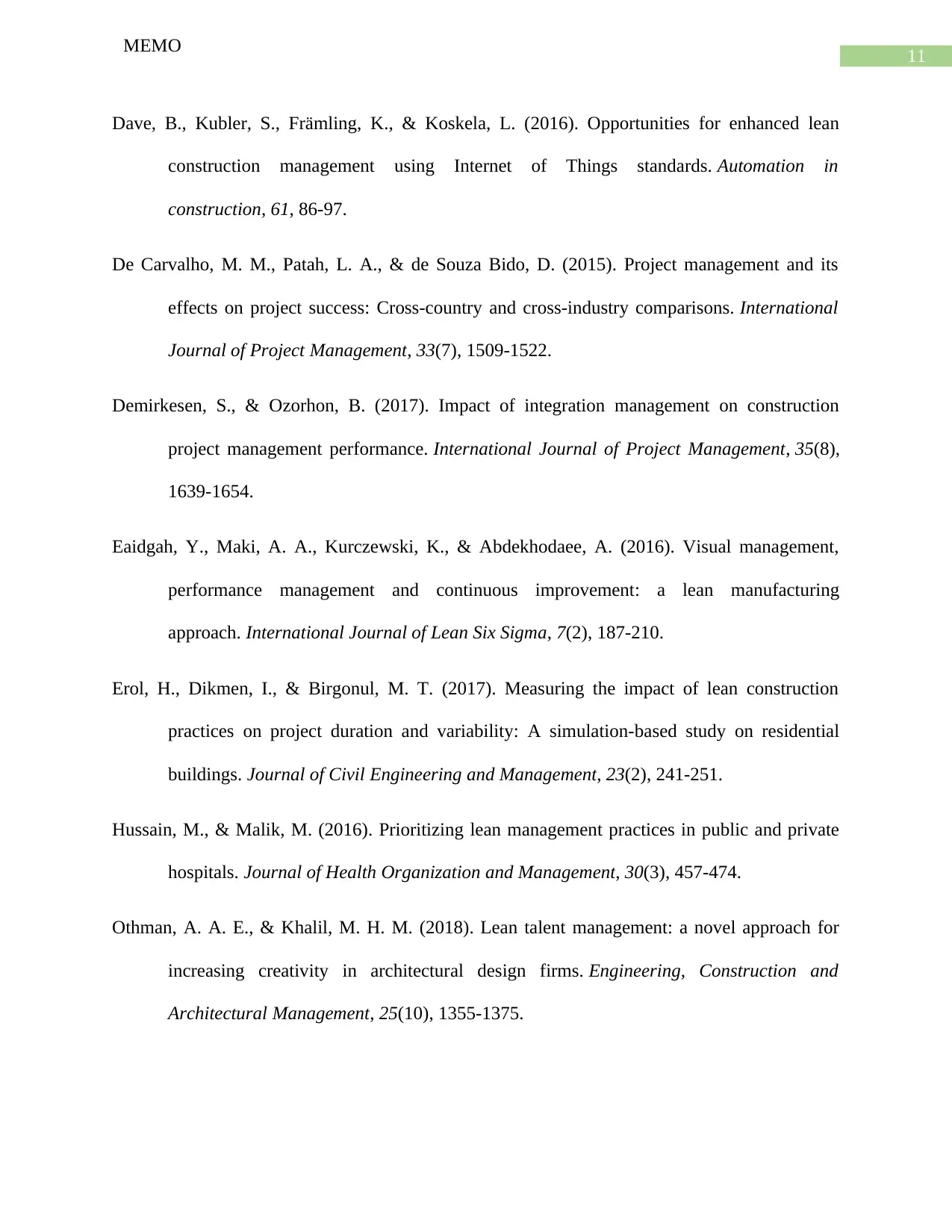
11
MEMO
Dave, B., Kubler, S., Främling, K., & Koskela, L. (2016). Opportunities for enhanced lean
construction management using Internet of Things standards. Automation in
construction, 61, 86-97.
De Carvalho, M. M., Patah, L. A., & de Souza Bido, D. (2015). Project management and its
effects on project success: Cross-country and cross-industry comparisons. International
Journal of Project Management, 33(7), 1509-1522.
Demirkesen, S., & Ozorhon, B. (2017). Impact of integration management on construction
project management performance. International Journal of Project Management, 35(8),
1639-1654.
Eaidgah, Y., Maki, A. A., Kurczewski, K., & Abdekhodaee, A. (2016). Visual management,
performance management and continuous improvement: a lean manufacturing
approach. International Journal of Lean Six Sigma, 7(2), 187-210.
Erol, H., Dikmen, I., & Birgonul, M. T. (2017). Measuring the impact of lean construction
practices on project duration and variability: A simulation-based study on residential
buildings. Journal of Civil Engineering and Management, 23(2), 241-251.
Hussain, M., & Malik, M. (2016). Prioritizing lean management practices in public and private
hospitals. Journal of Health Organization and Management, 30(3), 457-474.
Othman, A. A. E., & Khalil, M. H. M. (2018). Lean talent management: a novel approach for
increasing creativity in architectural design firms. Engineering, Construction and
Architectural Management, 25(10), 1355-1375.
MEMO
Dave, B., Kubler, S., Främling, K., & Koskela, L. (2016). Opportunities for enhanced lean
construction management using Internet of Things standards. Automation in
construction, 61, 86-97.
De Carvalho, M. M., Patah, L. A., & de Souza Bido, D. (2015). Project management and its
effects on project success: Cross-country and cross-industry comparisons. International
Journal of Project Management, 33(7), 1509-1522.
Demirkesen, S., & Ozorhon, B. (2017). Impact of integration management on construction
project management performance. International Journal of Project Management, 35(8),
1639-1654.
Eaidgah, Y., Maki, A. A., Kurczewski, K., & Abdekhodaee, A. (2016). Visual management,
performance management and continuous improvement: a lean manufacturing
approach. International Journal of Lean Six Sigma, 7(2), 187-210.
Erol, H., Dikmen, I., & Birgonul, M. T. (2017). Measuring the impact of lean construction
practices on project duration and variability: A simulation-based study on residential
buildings. Journal of Civil Engineering and Management, 23(2), 241-251.
Hussain, M., & Malik, M. (2016). Prioritizing lean management practices in public and private
hospitals. Journal of Health Organization and Management, 30(3), 457-474.
Othman, A. A. E., & Khalil, M. H. M. (2018). Lean talent management: a novel approach for
increasing creativity in architectural design firms. Engineering, Construction and
Architectural Management, 25(10), 1355-1375.
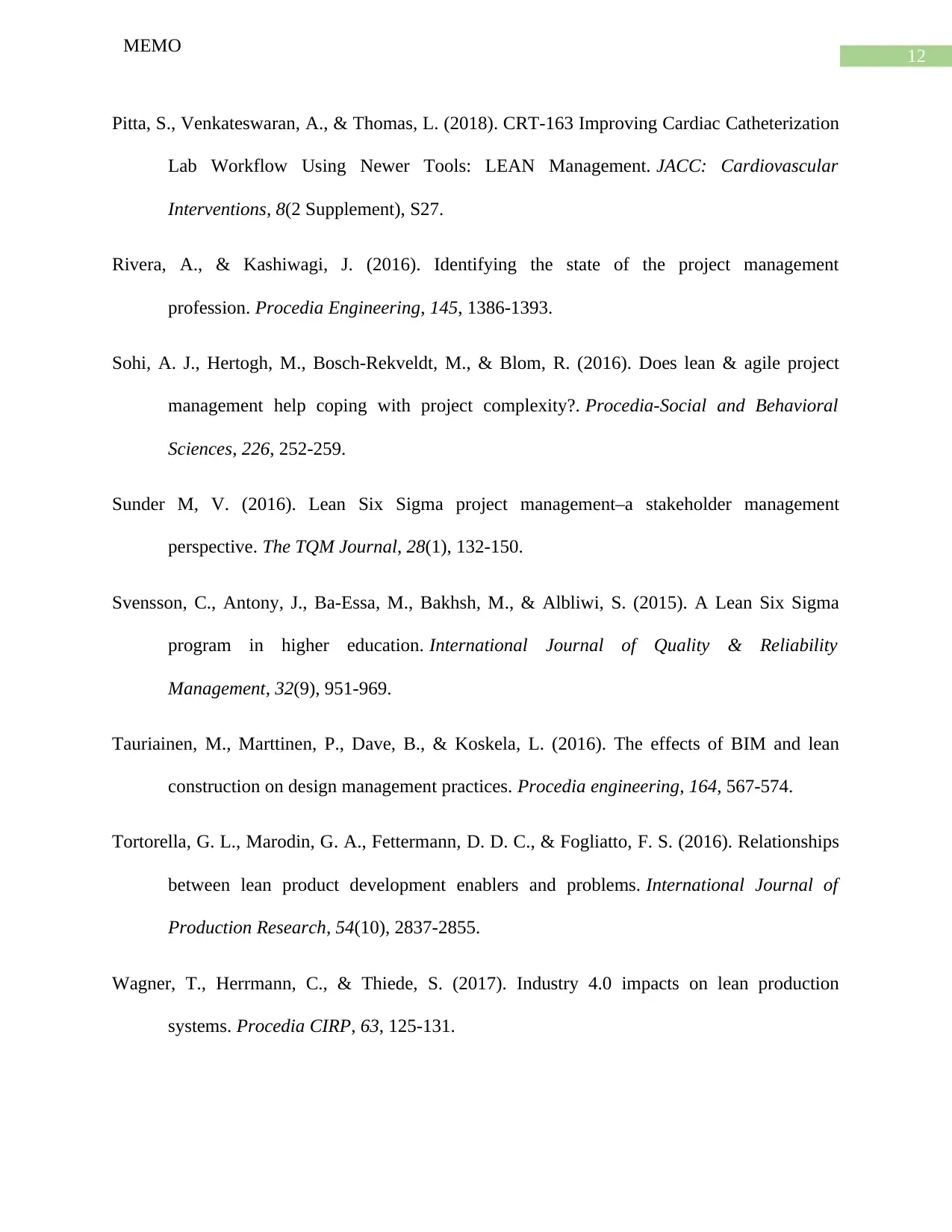
12
MEMO
Pitta, S., Venkateswaran, A., & Thomas, L. (2018). CRT-163 Improving Cardiac Catheterization
Lab Workflow Using Newer Tools: LEAN Management. JACC: Cardiovascular
Interventions, 8(2 Supplement), S27.
Rivera, A., & Kashiwagi, J. (2016). Identifying the state of the project management
profession. Procedia Engineering, 145, 1386-1393.
Sohi, A. J., Hertogh, M., Bosch-Rekveldt, M., & Blom, R. (2016). Does lean & agile project
management help coping with project complexity?. Procedia-Social and Behavioral
Sciences, 226, 252-259.
Sunder M, V. (2016). Lean Six Sigma project management–a stakeholder management
perspective. The TQM Journal, 28(1), 132-150.
Svensson, C., Antony, J., Ba-Essa, M., Bakhsh, M., & Albliwi, S. (2015). A Lean Six Sigma
program in higher education. International Journal of Quality & Reliability
Management, 32(9), 951-969.
Tauriainen, M., Marttinen, P., Dave, B., & Koskela, L. (2016). The effects of BIM and lean
construction on design management practices. Procedia engineering, 164, 567-574.
Tortorella, G. L., Marodin, G. A., Fettermann, D. D. C., & Fogliatto, F. S. (2016). Relationships
between lean product development enablers and problems. International Journal of
Production Research, 54(10), 2837-2855.
Wagner, T., Herrmann, C., & Thiede, S. (2017). Industry 4.0 impacts on lean production
systems. Procedia CIRP, 63, 125-131.
MEMO
Pitta, S., Venkateswaran, A., & Thomas, L. (2018). CRT-163 Improving Cardiac Catheterization
Lab Workflow Using Newer Tools: LEAN Management. JACC: Cardiovascular
Interventions, 8(2 Supplement), S27.
Rivera, A., & Kashiwagi, J. (2016). Identifying the state of the project management
profession. Procedia Engineering, 145, 1386-1393.
Sohi, A. J., Hertogh, M., Bosch-Rekveldt, M., & Blom, R. (2016). Does lean & agile project
management help coping with project complexity?. Procedia-Social and Behavioral
Sciences, 226, 252-259.
Sunder M, V. (2016). Lean Six Sigma project management–a stakeholder management
perspective. The TQM Journal, 28(1), 132-150.
Svensson, C., Antony, J., Ba-Essa, M., Bakhsh, M., & Albliwi, S. (2015). A Lean Six Sigma
program in higher education. International Journal of Quality & Reliability
Management, 32(9), 951-969.
Tauriainen, M., Marttinen, P., Dave, B., & Koskela, L. (2016). The effects of BIM and lean
construction on design management practices. Procedia engineering, 164, 567-574.
Tortorella, G. L., Marodin, G. A., Fettermann, D. D. C., & Fogliatto, F. S. (2016). Relationships
between lean product development enablers and problems. International Journal of
Production Research, 54(10), 2837-2855.
Wagner, T., Herrmann, C., & Thiede, S. (2017). Industry 4.0 impacts on lean production
systems. Procedia CIRP, 63, 125-131.
1 out of 13
Related Documents
Your All-in-One AI-Powered Toolkit for Academic Success.
+13062052269
info@desklib.com
Available 24*7 on WhatsApp / Email
![[object Object]](/_next/static/media/star-bottom.7253800d.svg)
Unlock your academic potential
© 2024 | Zucol Services PVT LTD | All rights reserved.




